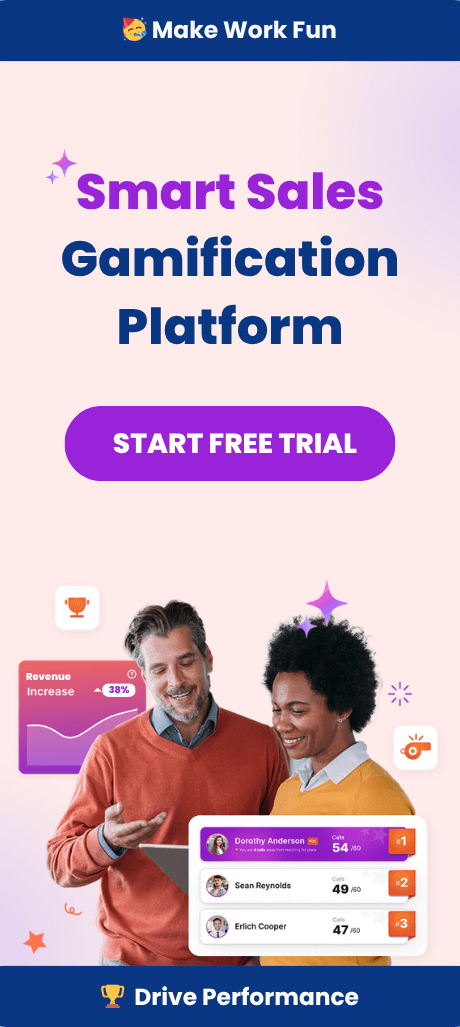Introducing The Leaderboard Paradox
The leaderboard paradox is a challenge faced by many sales teams: while leaderboards are designed to motivate and engage sales professionals, they can sometimes have the opposite effect. When sales teams become fixated on their ranking, the focus can shift away from the sales process and building meaningful customer relationships. This tunnel vision can undermine collaboration, hinder skill development, and ultimately reduce overall sales performance.
Sales managers play a crucial role in navigating this paradox. By balancing the use of leaderboards with initiatives that encourage teamwork, continuous learning, and a customer-first mindset, sales managers can ensure that leaderboards remain a tool for motivation rather than a source of stress. The key is to create an environment where sales professionals are inspired to lead, develop new skills, and perform at their best—not just chase a number on a screen.
Leaderboards have long been a staple of sales organizations. Most companies rely on leaderboards as a standard motivational tool in their sales organizations. They motivate, recognize top performers, and spark a little healthy competition. But for many sales professionals, especially those who don’t often see their name in the top three, leaderboard fatigue is real. What once inspired greatness can now spark burnout, disengagement, and frustration. In this article, we’ll show you how to reframe the approach towards leaderboards.
What Is Leaderboard Fatigue?

Leaderboard fatigue occurs when sales team members become demotivated or disengaged due to the constant pressure of leaderboard rankings. Leaderboards often rely on extrinsic motivation, such as public recognition or rewards, which can lose effectiveness over time and contribute to fatigue. Over time, what was meant to boost morale becomes a reminder of missed sales targets or unachieved goals.
This fatigue can manifest in several ways. Some sales reps may begin to ignore the leaderboard altogether, feeling that no matter how hard they try, they cannot reach the top spots. Others may experience increased stress and anxiety, which can negatively impact their overall sales performance and job satisfaction. In some cases, leaderboard fatigue can even lead to higher turnover rates as sales professionals seek environments with less pressure and more supportive recognition systems.
Moreover, leaderboard fatigue does not just affect individual sales reps; it can also harm the cohesion and morale of the entire sales team. When only a handful of top performers receive recognition, it can create feelings of exclusion and resentment among other team members. This dynamic may discourage collaboration and knowledge sharing, which are essential for building a successful sales team.
Understanding the Causes of Leaderboard Fatigue
Leaderboard fatigue often sets in when sales teams lose sight of clear goals or feel disconnected from the purpose behind the rankings. If leaderboards are not aligned with the sales process or key sales metrics, sales professionals may struggle to see how their daily efforts contribute to the bigger picture. A lack of timely feedback and meaningful rewards can further erode motivation, making the leaderboard feel more like a scoreboard of missed opportunities than a celebration of progress.
To keep the sales team engaged, sales managers should regularly review their leaderboard strategy, ensuring it reflects the realities of the sales process and supports the team’s sense of achievement. By setting clear goals, providing actionable feedback, and recognizing a variety of contributions, sales managers can create a leaderboard experience that truly motivates and energizes their teams.
The Psychological Toll on Sales Reps
Sales professionals, or sales representatives, face constant pressure to meet demanding quotas and deliver consistent results. This pressure often leads to heightened stress and anxiety, especially when leaderboards spotlight only a select few top performers. Those not featured prominently may feel overlooked or undervalued, which can diminish their motivation and sense of belonging within the team. Over time, this psychological strain can negatively impact their confidence and overall job satisfaction.
Such feelings of exclusion and inadequacy can ripple through the entire sales organization, reducing collaboration and increasing turnover. When sales reps perceive leaderboards as a source of judgment rather than encouragement, it undermines team cohesion and hampers the collective drive toward shared sales goals.
Why Traditional Leaderboards Are Broken

The traditional format of showcasing the top 3-5 performers fails to consider the nuances of each sales process. Traditional leaderboards are often structured like a game, using game design elements such as points and rankings to drive competition, but this approach can have unintended consequences. It reinforces a “winner-takes-all” mentality, alienating those who may be improving but not at the top yet.
Sales Process and Leaderboard Fatigue
The way leaderboards are integrated into the sales process can make or break their effectiveness. When designed thoughtfully, leaderboards can support a sales team by promoting healthy competition, recognizing both individual and group achievements, and driving overall sales performance. However, if leaderboards focus solely on individual results, they can foster a cutthroat atmosphere that undermines collaboration among team members.
This can lead to leaderboard fatigue, where the sales organization sees a drop in motivation and teamwork. Sales managers should ensure that leaderboards are aligned with the broader sales strategy, highlighting not just closed deals but also key activities and milestones throughout the sales process. By doing so, they create a culture where every team member feels valued and motivated to contribute to the organization’s success.
The Role of Sales Managers in Mitigating Fatigue
Sales managers and sales leaders have the power to transform leaderboard culture. By shifting the focus from only top-line results to key sales metrics like activity levels, pipeline growth, and customer satisfaction, they can inspire more balanced and sustainable success. Managing leaderboard culture requires ongoing attention to both results and team well-being.
Effective Sales Leadership in the Modern Sales Environment

In today’s dynamic sales environment, effective sales leadership is more important than ever for building a high performing sales team. Sales leaders must be agile, leveraging digital tools and data-driven insights to guide their teams. By focusing on continuous skill development and adapting sales strategies to meet changing customer needs, sales leaders can drive business growth and long-term success.
This means understanding the sales process inside and out, tracking key sales metrics, and fostering a culture where sales professionals are motivated to learn and excel. When sales managers prioritize the growth of their team and align their strategies with market demands, they create a sales organization that is not only resilient but also poised for sustained achievement.
Recognizing Diverse Achievements
Every successful sales team has reps who excel at different stages—prospecting, qualifying, and closing. Highlighting only closed deals on a leaderboard neglects the diverse strengths that fuel business growth. It’s crucial to spotlight a wider range of contributions, such as pipeline development, customer engagement, and lead nurturing. Recognizing these varied achievements not only motivates a broader group of sales professionals but also encourages a more balanced and effective sales process.
By acknowledging diverse accomplishments, sales managers foster an inclusive environment where all team members feel valued. This approach drives sustained motivation, improves team collaboration, and ultimately enhances overall sales performance.
The Importance of Fair Visibility
Giving equal visibility to all types of success fosters inclusivity. Other roles, such as customer success managers or marketing liaisons, also play a crucial part in long-term success and should be recognized. A sales rep who consistently builds qualified pipeline or re-engages dormant accounts contributes just as much to long-term success as one closing big deals.
Reframing Competition into Collaboration
While competition drives performance, overemphasis can undermine team collaboration, which is essential for overall success. Sales leaders can foster collaboration by pairing top reps with developing team members, turning competition into mentorship. This approach not only boosts individual skills but also strengthens team bonds, creating a supportive environment where everyone thrives. By shifting the focus from rivalry to shared growth, sales teams can unlock collective potential and drive sustained business growth.
Encouraging collaboration transforms leaderboards from a source of stress into a platform for learning and encouragement. When team members celebrate each other’s wins and work together towards common goals, motivation soars, and leaderboard fatigue diminishes. This balance of healthy competition and teamwork cultivates a high performing sales team that excels both individually and as a cohesive unit.
Incorporating Real-Time Micro-Wins
Small wins in various sales activities, such as setting meetings, qualifying leads, or delivering demos, should be celebrated in real time to maintain momentum and boost morale. Recognizing these micro-achievements helps existing sales reps feel valued and motivated throughout the sales cycle, not just at the end.
Tools like Spinify gamify these moments by providing instant feedback and rewards, turning routine tasks into engaging challenges. Celebrating micro-wins fosters a positive mindset, encourages consistent effort, and reduces the risk of burnout by highlighting progress every step of the way.
Personalized Dashboards: One Size Doesn’t Fit All
Personalized dashboards tailored to each sales team member’s job profile, role, seniority, and KPIs can transform performance tracking into a more motivating and relevant experience. Junior account executives shouldn’t be measured by the same metrics as senior closers, as their contributions and responsibilities differ significantly.
Custom dashboards allow sales reps to focus on their unique goals and strengths, providing clearer insights into their progress. This individualized approach helps sales professionals build relationships with their own performance data, increasing engagement, accountability, and ultimately driving better sales outcomes.
Leaderboards That Evolve with the Sales Cycle
Creating leaderboards that evolve with the sales cycle ensures ongoing relevance and sustained motivation for sales professionals. Sales goals naturally shift throughout the quarter—from prospecting and outreach in the early stages to closing deals as deadlines approach.
By adapting leaderboards to highlight the most critical activities at each phase, sales managers can keep the team’s focus aligned with current priorities. This dynamic approach prevents stagnation and fatigue, encourages balanced effort across all sales activities, and helps build a well-rounded, high performing sales team that consistently meets its targets.
The Impact of Burnout on Sales Strategy
Leaderboard fatigue is often a symptom of deeper burnout within a sales team. Burnout negatively affects cognitive function, decision-making, and interpersonal relationships—key elements necessary for executing any effective sales strategy.
When sales professionals are exhausted or disengaged, the quality of service they provide to customers suffers, which can lead to lost opportunities and decreased customer satisfaction. Recognizing and addressing burnout early is essential for maintaining a motivated, resilient sales organization that can adapt its sales strategy to meet evolving market demands and sustain long-term business growth.
Encouraging Intrinsic Motivation
Intrinsic motivation—driven by personal purpose, passion, and a sense of mastery—has far greater staying power than external rewards like prizes or rankings. Sales leaders must help team members connect their daily tasks to broader business growth and personal career goals to foster this deeper motivation.

By emphasizing meaningful work, opportunities for skill development, and alignment with company values, sales managers can cultivate a culture where sales professionals feel empowered and engaged. This intrinsic drive leads to higher job satisfaction, better performance, and a more sustainable, high performing sales team.
Using Gamification Wisely
Gamification works—when done right. The focus should be on progress, not just placement. Platforms like Spinify offer all the features needed to gamify sales engagement, including tools to make repetitive tasks more enjoyable and motivating. By turning routine activities into fun challenges, sales leaders can boost intrinsic motivation and keep their teams energized. Customizable games and rewards allow for a personalized experience that celebrates every milestone, big or small, without adding pressure.
This thoughtful approach transforms leaderboards from a source of stress into a powerful tool for engagement. Sales professionals feel recognized for consistent effort and skill development, fostering a positive, high-performing sales culture where motivation thrives and burnout diminishes.
Reassessing Your Hiring Process
A hiring process that focuses on finding the right new hire who fits both the sales role and the company’s culture will build a successful sales team less prone to leaderboard fatigue. Soft skills matter just as much as the ability to close.
Focusing on Developmental Metrics
Businesses often overlook developmental metrics like training sessions attended, certifications completed, and CRM hygiene, yet these are critical to long-term success. Recognizing and managing these metrics keeps everyone in the sales organization aligned and progressing.
Developing Sales Skills and Evolving Job Profiles
As the sales landscape evolves, so too must the skills and job profiles of sales professionals. Today’s sales team needs to be highly motivated, adaptable, and skilled in areas like digital communication, data analysis, and customer relationship management. Sales managers play a pivotal role in supporting the ongoing development of their team members, offering training and resources that help them acquire new skills and stay ahead of market trends.
By fostering a culture of continuous learning and encouraging team members to embrace new sales strategies, organizations can build a skilled and motivated sales force ready to succeed with customers and prospects alike. This commitment to growth not only benefits individual sales professionals but also strengthens the entire sales organization, ensuring long-term success in a competitive market.
Aligning Marketing Strategy with Sales Goals
When marketing and sales teams collaborate closely, the entire organization reaps significant benefits. Coordinated efforts such as joint email campaigns create a unified message that resonates with prospects and customers alike. Shared feedback loops ensure that insights from sales conversations inform marketing tactics, while marketing data helps sales reps tailor their approach.
Co-owning KPIs fosters accountability and breaks down silos, reducing blame-shifting and promoting a culture of teamwork. This alignment ultimately drives more efficient lead conversion and supports sustainable business growth.
Spotlighting Long-Tail Success
Not all sales victories are immediate—some deals require months of nurturing and relationship-building. Sales reps who manage long pipelines or focus on upselling existing clients play a critical role in maintaining revenue stability, even if they don’t appear on monthly leaderboards.
Highlighting and recognizing these long-tail successes ensures that valuable contributions don’t go unnoticed. By celebrating the persistence and strategic thinking involved, organizations encourage a balanced approach that values both quick wins and sustained customer engagement.
Rewarding Consistency Over Flashy Wins
While flashy, last-minute deals can generate excitement, they may also create volatility in team morale and obscure steady performers’ contributions. Rewarding consistent, reliable sales efforts fosters a culture of sustainability and long-term success.
This approach motivates sales professionals to focus on building strong customer relationships and maintaining a healthy pipeline rather than chasing quick wins. As the business grows and scales, emphasizing consistency helps stabilize performance, reduce burnout, and build a resilient, high performing sales team.
Building a Feedback-Rich Environment
Creating a culture rich in continuous feedback between sales reps, managers, and peers is essential for growth and engagement. When team members feel their voices are heard and their efforts acknowledged, they are less likely to disengage or experience leaderboard fatigue.
Regular, constructive feedback encourages skill development, fosters openness, and builds trust within the team. This environment aligns with the organization’s commitment to personal and professional growth, ultimately driving higher sales performance and stronger team cohesion.
Leveraging Team Challenges

Incorporating weekly or monthly team challenges with shared goals encourages all sales team members to contribute actively to collective success. These challenges should be designed to be fun, varied, and relevant to current sales objectives, promoting healthy competition and camaraderie.
By focusing on team-based achievements rather than just individual rankings, organizations reinforce collaboration and mutual support. This approach helps sustain motivation across the entire sales organization and diminishes feelings of exclusion often associated with traditional leaderboards.
Structuring Recognition Rituals
Many successful companies boost motivation and morale by celebrating wins through structured recognition rituals such as team meetings, Slack shoutouts, or newsletters. These consistent, public acknowledgments provide positive reinforcement without overemphasizing digital rankings, helping to maintain enthusiasm over time.
By recognizing a wide range of achievements—from small daily wins to major milestones—organizations create an inclusive culture where every sales team member feels valued and inspired to contribute their best efforts consistently.
The Executive Buy-In Factor
Achieving meaningful change in leaderboard culture requires strong executive buy-in. When C-suite leaders prioritize only closed deals, it sends a message that can skew the entire sales team’s focus. Leadership must actively endorse a multi-metric recognition approach that values diverse contributions like prospecting, pipeline development, and customer engagement.
This top-down support empowers sales managers to implement balanced strategies that combat leaderboard fatigue effectively and promote sustainable team performance, ultimately driving business growth and a healthier sales culture.
Experimenting and Iterating
No leaderboard or recognition system is perfect from the start. Sales leaders should commit to regularly gathering feedback from their teams and analyzing performance data to refine these processes continually. This iterative approach allows organizations to adapt recognition methods to evolving sales goals and team dynamics.
By embracing experimentation, sales managers can ensure that leaderboards remain relevant, motivating, and supportive, fostering a resilient and engaged sales organization that thrives even in changing market conditions.
The Future: Leaderboards Reimagined
Leaderboard fatigue is real, but it’s not irreversible. By reframing recognition, celebrating diverse contributions, and leveraging smart tools, any sales organization can transform their culture from stressful to supportive.
Try Spinify todayto gamify success, not just the scoreboard. Keep your sales professionals motivated, your sales team engaged, and your business growth unstoppable.




